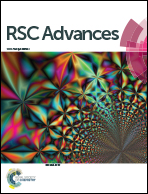Large d33 and enhanced ferroelectric/dielectric properties of poly(vinylidene fluoride)-based composites filled with Pb(Zr0.52Ti0.48)O3 nanofibers†
Abstract
Pb(Zr0.52Ti0.48)O3 (PZT) nanofibers with diameters of 150–200 nm are prepared via electrospinning and used as dielectric fillers in poly(vinylidene fluoride) (PVDF)-based composite films. Highly flexible polymer composite films are fabricated with a solution cast method. Enhanced dielectric constants are obtained at low volume fraction of PZT nanofibers. The orientation of PZT nanofibers perpendicular to the external electric field gives rise to improved dielectric breakdown strength. A subsequent uniaxial stretching of the composite films leads to higher crystallinity and breakdown strength of the polymer composites, which is favorable for the polarization of the nanocomposites at higher electric fields. Enhanced ferroelectric properties, i.e., higher saturated and remnant polarization, are obtained in these composite films. A high piezoelectric coefficient (d33) of ∼87.4 pm V−1 is also achieved for the polymer composite films filled with only 2.4 vol% of PZT nanofibers. The results show that the PZT/PVDF composite films have potential applications in piezoelectric sensors, and even piezoelectric actuators.


 Please wait while we load your content...
Please wait while we load your content...